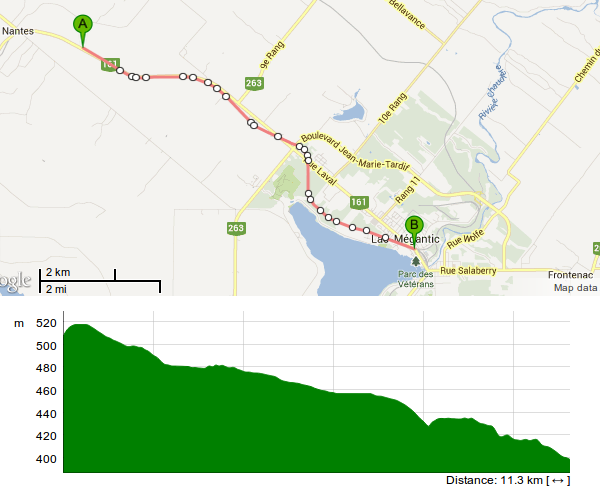The Lac-Megantic Incident, It’s All About The Brakes
July 9th, 2013 by ant6nThe Lac-Megantic incident was caused by an apparently unmanned train of the Montreal, Maine and Atlantic Railway (MMA) loaded with crude blasting into a small town at high speed. The train consisted of 72 “DOT-111” tanker cars, which have been criticized in the past to “have a high incidence of tank failures during accidents” (NTSB report report, page 75).
There’s a sharp curve in downtown, and that’s where an explosion and subsequent fire destroyed a large number of buildings, and killed at least 13 people. This happened during Friday night, bad timing because there were some festivities in a bar that was engulfed in the fire (video).
A Timeline
The investigation is still ongoing, so explaining causes is basically just speculation. But we have some information, let’s look at a timeline leading up to the explosion:
- 23:25 The engineer parked the train with 72 crude-carrying tanker cars at a siding near Nantes, QC. This is about 10~11km away from downtown Lac-Megantic. The engineer shut down four of the five engines and left the lead engine (#5017) running to supply the air brakes.
- 23:30 A resident called 911 to report a locomotive engine on fire at the Nantes siding.
- 23:42 Firefighters arrive on the scene. As part of their operations, They shut down the lead engine. The Nantes Fire Chief Patrick Lambert told Reuters that the crew had switched off the locomotive a “good-sized” blaze in the motor, possibly caused by a fuel or oil leak in the engine. “We shut down the engine before fighting the fire.” “Our protocol calls for us to shut down an engine because it is the only way to stop the fuel from circulating into the fire.”
- 0:12 The fire is extinguished
- 0:13-12:15 Two emplyes of the (MMA) show up at the scene
- 1:30 The train derails at high speed at Lac-Megantics Rue Frontenac crossing.
According to MMA’s chairman Ed Burkhardt, the brakes will not work if a train is switched off: “If the operating locomotive is shut down, there’s nothing left to keep the brakes charged up, and the brake pressure will drop finally to the point where they can’t be held in place any longer”.
How many brakes in a train?
A train relies on air brakes to keep the cars from moving. There’s a high pressure air line running through the whole train, supplying power to the brakes and activating the brakes. The brakes are fail-safe, that is they release at high pressure, lower pressure means ‘stop’. If the air pressure fails, it will go into emergency brake mode and stop. The energy for that braking action is supplied by an air pressure reservoir on each car. However, these reservoirs can deplete after a while and will release the brakes. That’s why the lead engine of the runaway train was kept on, so that the onboard air-compressor could maintain the air brake pressure.
Since the air brakes can stop working, every car also has hand brakes, operated by a large steering wheel. The Canadian Rail Operating Rules (CROR) specifies the following:
112. SECURING EQUIPMENT
(a) When equipment is left at any point a sufficient number of hand brakes must be applied to prevent it from moving. Special instructions will indicate the minimum hand brake requirements for all locations where equipment is left. (…)
Equipment here is defined as “One or more engines and/or cars which can be handled on their own wheels in a movement.” The rules also specify that sufficient application of handbrakes has to be tested:
(b) Before relying on the retarding force of the hand brake(s), whether leaving equipment or riding equipment to rest, the effectiveness of the hand brake(s) must be tested by fully applying the hand brake(s) and moving the cut of cars slightly to ensure sufficient retarding force is present to prevent the equipment from moving. When leaving a cut of cars secured, and after completion of this test, the cut should be observed while pulling away to ensure slack action has settled and that the cars remain in place.
So the air brakes may have been made ineffective related to the fire on the lead engine and the fire department operations. But the hand-brakes should have still prevented the trains from moving, if properly applied according to the operating rules. There may not have been enough hand brake force. The MMA claimed that hand brakes were engaged on all five engines, but it is unclear on how many cars, and whether the brake test was performed.
Even if the magnitude of the incident at Lac-Megantic is unusual, air brakes failing and insufficient hand brake force resulting in run-away equipment and a subsequent collision is not. This is exactly what happened in a January 2012 collision near Hanlon, Alberta.
One detail that is unusual is that there was only a single engineer. Usually, freight trains are staffed by an engineer (as the ‘driver’) and a conductor, who among other things has the responsibility to operate the hand brakes. One could speculate that without the conductor, it is too much work to walk along the train and operate a set of hand brakes, then get back into the engine to perform the brake tests. It turns out that in 2012 Transport Canada actually allowed the MMA to operate with reduced staffing levels.
A Runaway Train Rolling Down the Hill
In the title image one can see the path from the Nantes siding to the point where the train derailed, a distance of a bit more than 10km. From the geoprofile one can see that path is basically all on a downward slope, for a total elevation difference of about a 100m. That elevation difference in 10km is a gradient of only about 1%. But steel rail on steel track has extremely low rolling resistance, and air resistance will only come into play at higher speeds.
It doesn’t matter very much whether whether there’s a 1% grade, a 10% grade or a roller-coaster falling down 100m, most of the potential energy will be transferred into the kinetic energy of the train moving forward. A simple calculation (E = mgh = mv²/2 => v = √2gh) shows that this energy can speed the train up to 160km/h, assuming no rolling and air resistance. Even half that is enough to derail the train at the downtown Lac-Megantic curve, and cause the disaster.
The train was travelling from from New Town, North Dakota, over 3000km to it’s destination at the Irving Oil Refinery in Saint John, New Brunswick; it also passed through Toronto.
The investigation will most likely center around all the brake failures. But I hope we will re-visit the safety of leaving trains full of dangerous substances unattended, on inclined sidings with grades targeting populated areas, or the purpose in general of moving crude oil over thousands of miles, whether it be by train or by pipeline.




July 9th, 2013 at 23:03
Thanks for posting this. The disaster was (as usual) lazily reported in the Australian press, leaving a thoughtful reader with more questions than substantive information, and your blog has clarified several points. I agree strongly with your concluding remark about the hazardousness of leaving long, heavy freight trains unattended on inclines without some rock-solid means of stopping it moving (or perhaps an alarm system to alert the train company and emergency services of a spontaneous launch into motion).
July 13th, 2013 at 17:04
Nice summary. Media coverage has been pretty bad as noted. The Canadian Class Is have supplemental hand-brake rules as part of their own rule book. TSB has an example of CN’s here: http://www.bst-tsb.gc.ca/eng/rapports-reports/rail/2012/r12e0004/r12e0004.asp Note that they have specific rules for trains tied down on grades. I’ve googled around for an MM&A ETT or System Special Instructions without much luck.
You mentioned the one-man crew issue. I think that’s significant. I also want to know more about crew rest. I’ve not seen Transport Canada’s hours of service regulations but I imagine they are similar to the FRA’s, 12 hours maximum on duty, so many hours rest before they can be called again, etc. It will be interesting to see how well rested the “crew” was.
Oh, yeah: break != brake
July 13th, 2013 at 17:52
couple of breaks slipped through…
October 15th, 2013 at 19:48
Most sidings I’ve scene have a permanent derail to prevent equipment from entering the main line. Even some CTC have them circuited in.
My experience with the railroads, there liars.
The MM&A was most likely negligent.
There should have been a special instruction relating to winding extra hand brakes on un attended trains.
The heavy crude trains are new, the one man crew is new.
They may have been using that siding for a hundred years and just started leaving heavy trains unattended as part of new operations.
This is the first time the air dropped, when the engine was shut
down.
Think about it, 2012 they got the OK for a one man crew.
That’s negligent in itself.
How can one guy secure the train and walk it, if he hits on a hot box detector or looses air, has to stop in route. Pretty cold up
there too.
A walk along 72 cars on some frozen starry night can be a cure for a railroad buff. Fifty cars can get you mugged in Chicago too.
Technically one guy can’t secure a train by himself anyhow. Because the engine is unattended until he wraps the correct number of brakes.
My first clue is when the CEO blamed the engineer. Then the company spokesman blamed the fire department.
Its obvious they were cutting corners with the inadequate crew. The bottom line is the biggest deal in the world to a lot of these dopes.
They probably took a fraction of what they saved and got hooker’s for the TSA officials at they Safety Summit Convention in Vegas.
But like a whipped cream bikini it just wont stick.
They will hang the engineer and everyone will be pretty much OK
with it.
July 24th, 2019 at 22:10
I just recently rehashed over several sources on this rail tragedy. 47 needlees deaths. The TSB Transportation Safety Board inquiry was very lax in not concluding one operator trains were an accident about to happen. In followup the CBC reporter said to our Transport Minister so what has changed. Right away she ducks behind well enough manually applied hand breaks were not set by the solo train engineer. Shes a lawyer and should have read the TSB report. The MMA manual called for 9 to be set and he set 5 to 7 and that is the root cause in her one-track mind. And the locomotive? Well it went past a Transport Canada unexpected safety check. Spewing oil out the stack and running like crap. Oh it was patched many days before internally before with 10 minute epoxy. And that or more brought of a dead cyliinder, motor surging and oil pooling in the mega hot turbo casing. The cause of the engine loco fire and the unintendex shut-down. Hmmm Must have been one of those deaf and blind TC safety inspectors they hire! And good god the cab driver who comes to drive the LE to hotel for some rest. He and the LE discuss just how crappy the loco engine is running while tbe stack spews globs of oil onto his taxi. Holywood could not dream up a better pre-disaster story. The LE had 5 other engines he could have used to leave idling and air powering the train brake line. But what we are not told is they had so many control circuit faults etc he was forced to rely on the lead engine that ran like crap hjs entire trip. For some slimeball insanely cheap RR owner to save bucks. And TC the TSB and our bought off politicians are so alouffe its gonna happen again somewhere in Canada. What has changed